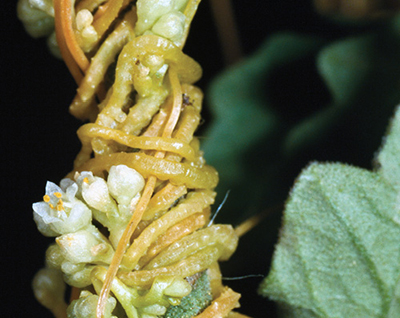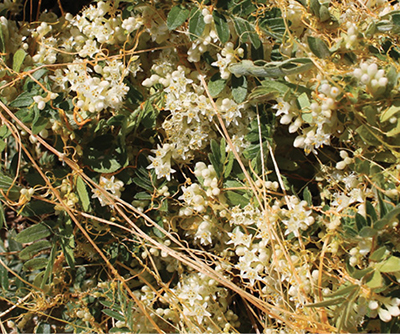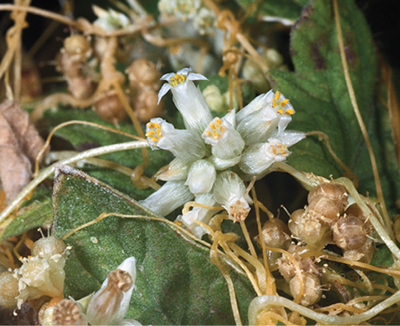Guide A-615
Revised by Leslie Beck
College of Agricultural, Consumer and Environmental Sciences, New Mexico State University
Author: Extension Weed Specialist, Department of Extension Plant Sciences, New Mexico State University. (Print Friendly PDF)
Introduction
There are over 150 species of dodders (Cuscuta spp.) worldwide. A member of the Convolvulaceae plant family, dodders are annual parasitic plants that reproduce by seed. They do not have any leaves or chlorophyll to derive nutrients from, and must therefore obtain all of their growth requirements (water, minerals, carbohydrates) by attach- ing themselves to other living green plants (host plants). Host plants include those grown for agricultural purposes, ornamental plants, range plants, and weeds.
Description and Life Cycle
In the spring, dodder seeds germinate near the soil surface and send up slender, thread-like twining stems varying in color from pale green to yellow or orange. The slender, leafless, thread-like stem sways or rotates slowly until it comes into contact with the stem or leaf of another plant and begins to wind around it (Figures 1 and 2). On a host plant, the dodder stem will immediately form small appendages called haustoria (tiny sucker-like roots), which penetrate the host stems or leaves so that dodder can extract its necessary growth requirements. Soon after attaching to a host plant, the lower end of the dodder withers and breaks its connec- tion with the ground, while the upper part of the stem grows rapidly, often forming dense, stringy masses. However, if the dodder seedlings are unable to make physical contact with a susceptible host plant soon after germination, they will not survive.

Figure 1. Dodder parasitizing a puncturevine (Tribulus terrestris) plant.

Figure 2. Dodder stems wind around the plants they parasitize. (Photo by J.M. DiTomaso; used with permission.)
Dodder flowers are numerous, tiny, and whitish to pinkish, and form in small clusters along the stems, generally from May to October depending on the species and location. Each flower forms a small, globular seedpod with 2 to 4 seeds (Figures 3 and 4). The seeds have rough coats and vary in size depending on the species and may be able to survive over 20 years in the soil.

Figure 3. Dodder flowers in small clusters along the stems.

Figure 4. Close-up of a dodder flower cluster. (Photo by J.M. DiTomaso; used with permission.)
Problems
Although there are several species of dodder distributed through- out North America, the most common species in the western U.S. are largeseed dodder (C. indecora) and field dodder (C. campestris). These species have become a major economic concern in alfalfa, clover cover crops, tomatoes, chile, and potatoes. Dodder infestations reduce crop yield and increase harvesting costs. The damage of dodder to the host plant varies from moderate to severe depending on the growth and health of the host plant and the number of haustoria attachments to the host plant.
Management
Dodder management is only achieved using combined preven- tive, cultural, mechanical, and chemical methods that aim to control existing populations prior to seed production and control subsequent seedlings. Fields with a history of dodder infestation need to be monitored frequently, and new dodder plants must be removed as soon as possible.
Prevention
Preventive management includes planting dodder-free crop seeds, cleaning agricultural machinery before moving from an infested area to a non-infested area, and managing existing populations prior to seed production so as to not spread dodder seeds. While small infestations can be removed by hand to prevent the produc- tion of seed, the recommendation for controlling extensive infes- tations is to remove the host plant and, if possible, replant with non-host crops.
Cultural Control
Planting non-host grass crops (e.g., corn, sorghum), winter crops (e.g., winter wheat, broccoli, legumes), and transplanted trees with bark (e.g., pecan) can be effective in managing dodder in an infested area. However, certain broadleaf weeds, such as pigweed, puncturevine, lambsquarter, Russian thistle, purslane, and field bindweed, serve as dodder host plants and will need to be effectively controlled as part of a successful dodder management strategy. Furthermore, due to the longevity of dodder seed, once a host crop is planted again, fields need to be monitored regularly, and new dodder plants must be removed immediately prior to establishment on a host plant.
Mechanical Control
Dodder infestation can be decreased by hand pulling, burning, cutting, or close mowing of the infested plants. If growers decide to use cultivation for dodder control, cultivation should be done prior to dodder’s attachment to the host plant.
Chemical Control
Several post-emergence (POST) and pre-emergence (PRE) herbi- cides are effective for dodder control/suppression. Common PRE herbicides (applied prior to dodder emergence) for dodder control include Kerb (pronamide), Treflan (trifluralin), and Prowl H2O (pendimethalin). POST application (applied after dodder emergence) of Dacthal (DCPA), Scythe (pelargonic acid), Raptor (imazamox), Pursuit (imazethapyr), or Gramoxone (paraquat) has been shown to be effective in dodder control/suppression (see Table 1 on page 4). Broadcast or selective (spot treatment) applications of Roundup (glyphosate) has also shown to provide good control of dodder; however, spot treatments of Roundup glyphosate will result in crop injury in non-Roundup Ready crops.
|
Table 1. Recommended POST and PRE Herbicides (based on dodder emergence and their crop registration) for Dodder Control in New Mexico* |
|||||
|---|---|---|---|---|---|
|
Herbicide |
Alfalfa |
Clover (rate/acre) |
Tomato (rate/acre) |
Potato |
Remarks |
|
Kerb |
PRE (1–4 lb) |
PRE |
NR** |
NR |
Required rates depend on type of irrigation. Excessive amounts of irrigation water following Kerb herbicide application may adversely affect the herbicide activity. |
|
Treflan |
PRE (1–4 pt) |
NR |
PRE |
PRE |
For optimal dodder control, the highest labeled rate should be used. Application rates are dependent upon soil type. Due to the lower registered rates in tomato and potato, herbicide may only provide partial control. |
|
Prowl H2O |
PRE |
NR |
PRE |
PRE |
For optimal dodder control, the highest labeled rate should be used. In seedling alfalfa, application rate is 1–2 pt of Prowl H2O/acre. |
|
Roundup PowerMAX |
POST |
NR |
NR |
NR |
Broadcast application is only recommended on Roundup Ready alfalfa. However, in conventional alfalfa, Roundup may be applied as a spot treatment or with wiper applicators. Applications may be made in the same area at 30-day intervals; however, no more than 10% of the total field area should be treated at one time. |
|
Dachtal (DCPA) |
NR |
NR |
PRE |
NR |
Tomato plants should be well-established prior to Dacthal application. For optimal dodder control, the highest labeled rate should be used. |
|
Raptor |
POST |
POST |
NR |
NR |
Raptor suppresses dodder prior to its attachment to the host plant. For optimal dodder control, the highest labeled rate should be used. |
|
Pursuit |
POST |
POST |
NR |
NR |
Pursuit suppresses dodder prior to its attachment to the host plant. For best results, Pursuit should be applied with crop oil concentrate or methylated seed oil. For optimal dodder control, the highest labeled rate should be used. |
|
Gramoxone SL |
POST |
POST (13–24 fl oz) |
NR |
NR |
Gramoxone SL is a restricted-use herbicide, so the applicator is required to be certified. Required rates depend on stage of alfalfa growth. Gramoxone SL will damage emerged or green plants. Apply between cuttings but before regrowth for dodder suppression. The rate of 1 pt of Gramoxone SL/acre is registered for between-cutting applications. |
|
Scythe |
POST (variable, 3–7%) |
POST (variable, 3–7%) |
POST (variable, 3–7%) |
POST (variable, 3–7%) |
Apply between cuttings but before regrowth for dodder suppression. Scythe will damage emerged or green plants. Apply with shielded spray between rows for fruiting vegetable and potato production. |
|
*Other trade names of the active ingredients alone or in combination may be available on the market. Additionally, label rates differ with different formulations. When considering the use of an herbicide, nothing can take the place of reading the label and making all applications according to label directions. Most labels can be accessed at either http://greenbook.net or http://cdms.net. **NR = not registered |
|||||
Acknowledgments
The critical reviews of this article by Dr. Jill Schroeder, Ms. Cheryl Fiore, and Mr. Mike Cowbrough are acknowledged.
References
Alex, J.F. 1998. Ontario weeds [Publication 505]. Guelph: Ontario Ministry of Agriculture, Food, and Rural Affairs.
Cudney, D.W., S.B. Orloff, and J.S. Reints. 1992. An integrated weed management procedure for the control of dodder (Cuscuta indecora) in alfalfa (Medicago sativa). Weed Technology, 6, 603–606.
Dawson, J.H., and A.R. Saghir. 1983. Herbicides applied to dodder (Cuscuta spp.) after attachment to alfalfa (Medicago sativa). Weed Science, 31, 465–471.
DiTomaso, J.M., and E.A. Healey. 2007. Weeds of California and other western states [Publication 3488]. Davis: University of California Agriculture and Natural Resources.
Lanini, W.T., D.W. Cudney, G. Miyao, and K.J. Hembree. 2002. Dodder. Davis: University of California Agriculture and Natural Resources. Retrieved April 2, 2009, from https://www.ipm.ucdavis.edu/PDF/PESTNOTES/pndodder.pdf
Whitson, T.D., L.C. Burrill, S.A. Dewey, D.W. Cudney, B.E. Nelson, R.D. Lee, and R. Parker. 2006. Weeds of the west, 9th ed. The Western Society of Weed Science in cooperation with the Western United States Land Grant Universities Cooperative Extension Services.
For further reading
A-325: Managing Weeds in Alfalfa
https://pubs.nmsu.edu/_a/A325/
A-340: Integrated Weed Management in Irrigated Permanent Grass Pastures and Hayfields in New Mexico
https://pubs.nmsu.edu/_a/A340/
H-158: How to Collect and Send Specimens for Disease Diagnosis
http://aces.nmsu.edu/pubs/_h/H158/
Original authors: Janshid Ashigh, Extension Weed Specialist; and Esther E. Marquez, Research Assistant.

Leslie Beck is the Extension Weed Specialist at New Mexico State University. Her research program focuses on integrated weed management systems in landscape, horticultural, and agronomic crops. Her Extension work provides the citizens of New Mexico with accurate, applicable, and effective weed identification and management strategies in multiple cropping systems.
The pesticide recommendations in this publication are provided only as a guide. The authors and New Mexico State University assume no liability resulting from their use. Please be aware that pesticide labels and registration can change at any time; by law, it is the applicator’s responsibility to use pesticides ONLY according to the directions on the current label. Use pesticides selectively and carefully and follow recommended procedures for the safe storage and disposal of surplus pesticides and containers.
Brand names appearing in publications are for product identification purposes only. No endorsement is intended, nor is criticism implied of similar products not mentioned. Persons using such products assume responsibility for their use in accordance with current label directions of the manufacturer.
To find more resources for your business, home, or family, visit the College of Agricultural, Consumer and Environmental Sciences on the World Wide Web at pubs.nmsu.edu
Contents of publications may be freely reproduced for educational purposes. All other rights reserved. For permission to use publications for other purposes, contact pubs@nmsu.edu or the authors listed on the publication.
New Mexico State University is an equal opportunity/affirmative action employer and educator. NMSU and the U.S. Department of Agriculture cooperating.
Revised December 2025 Las Cruces, NM


